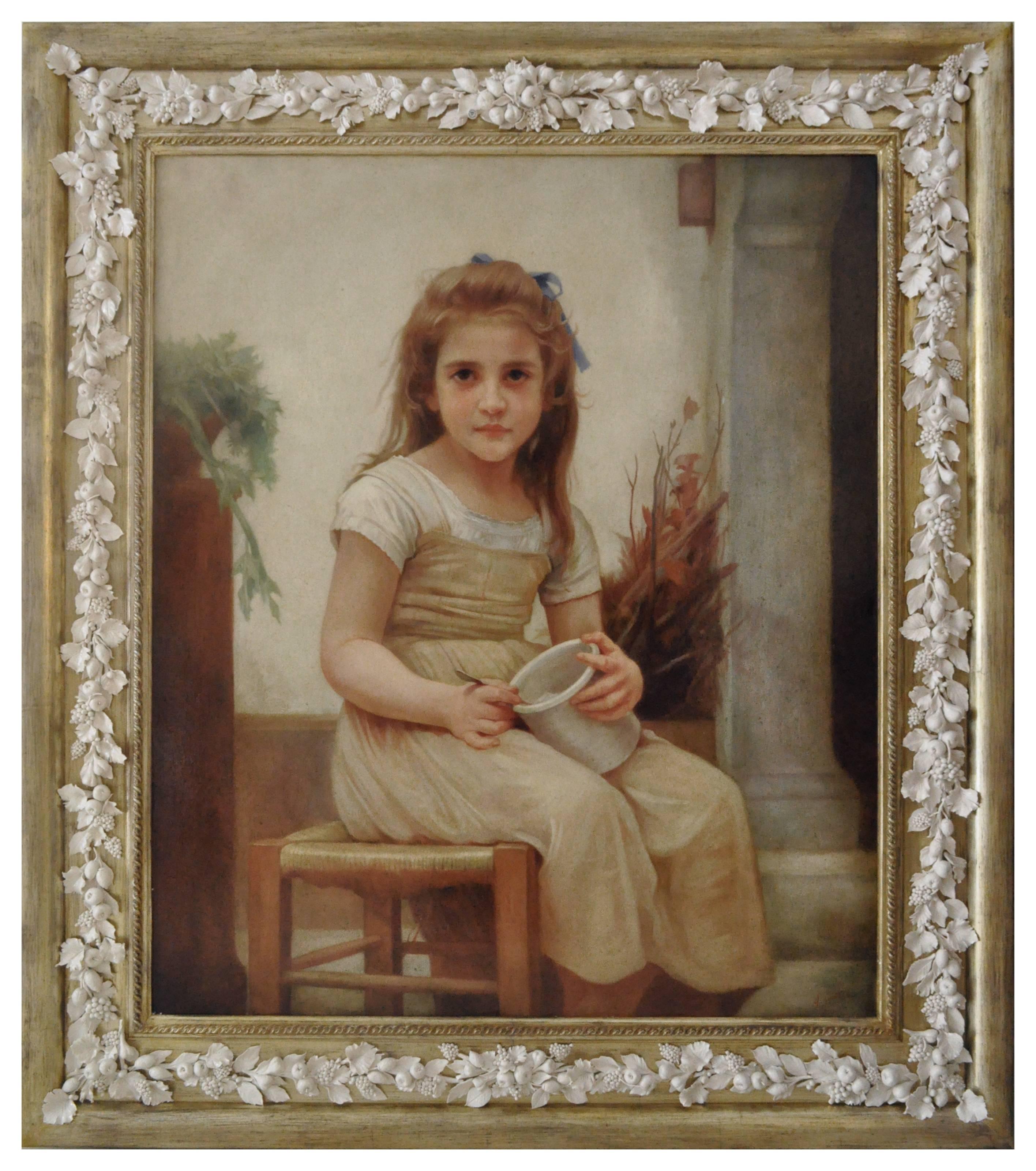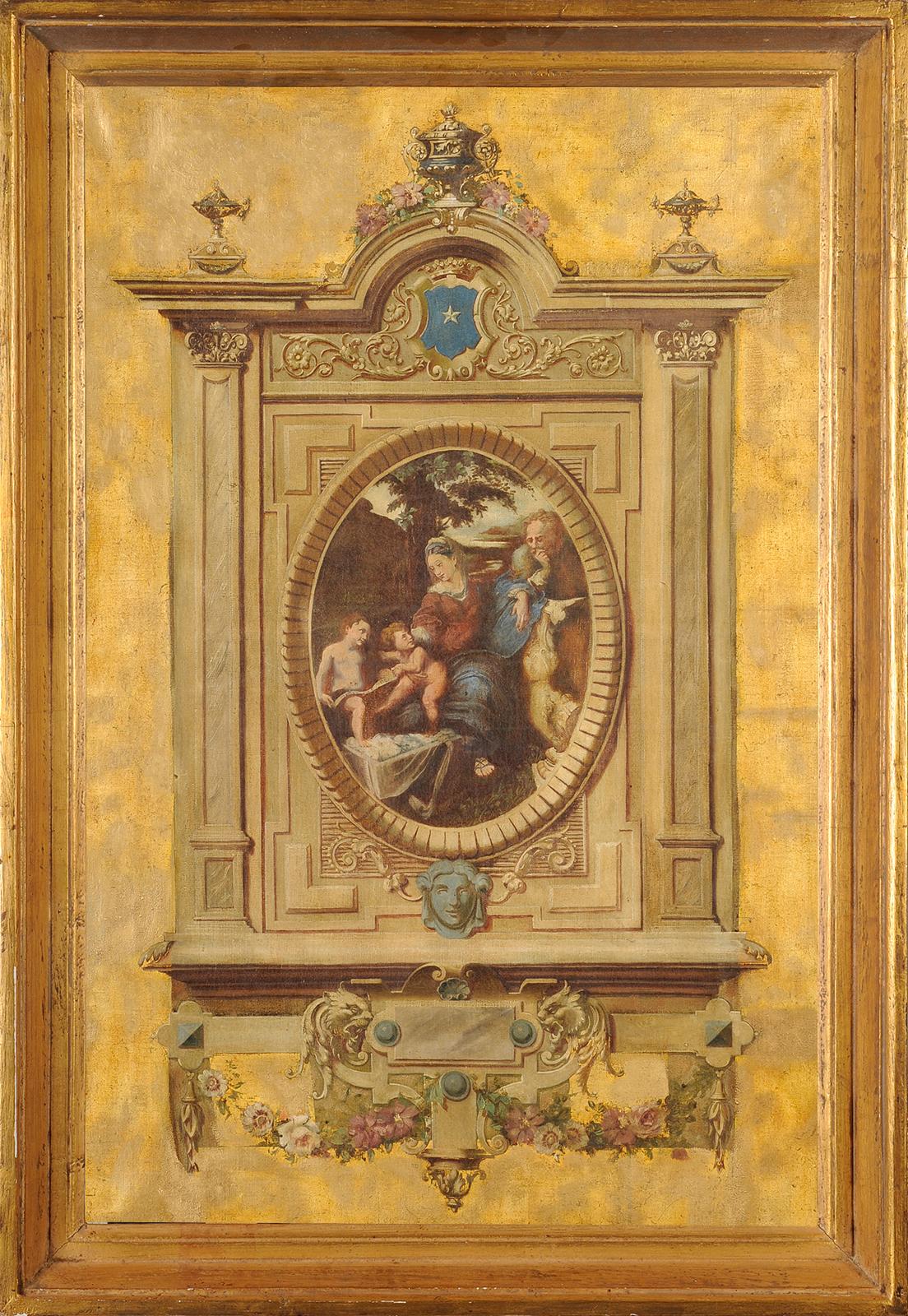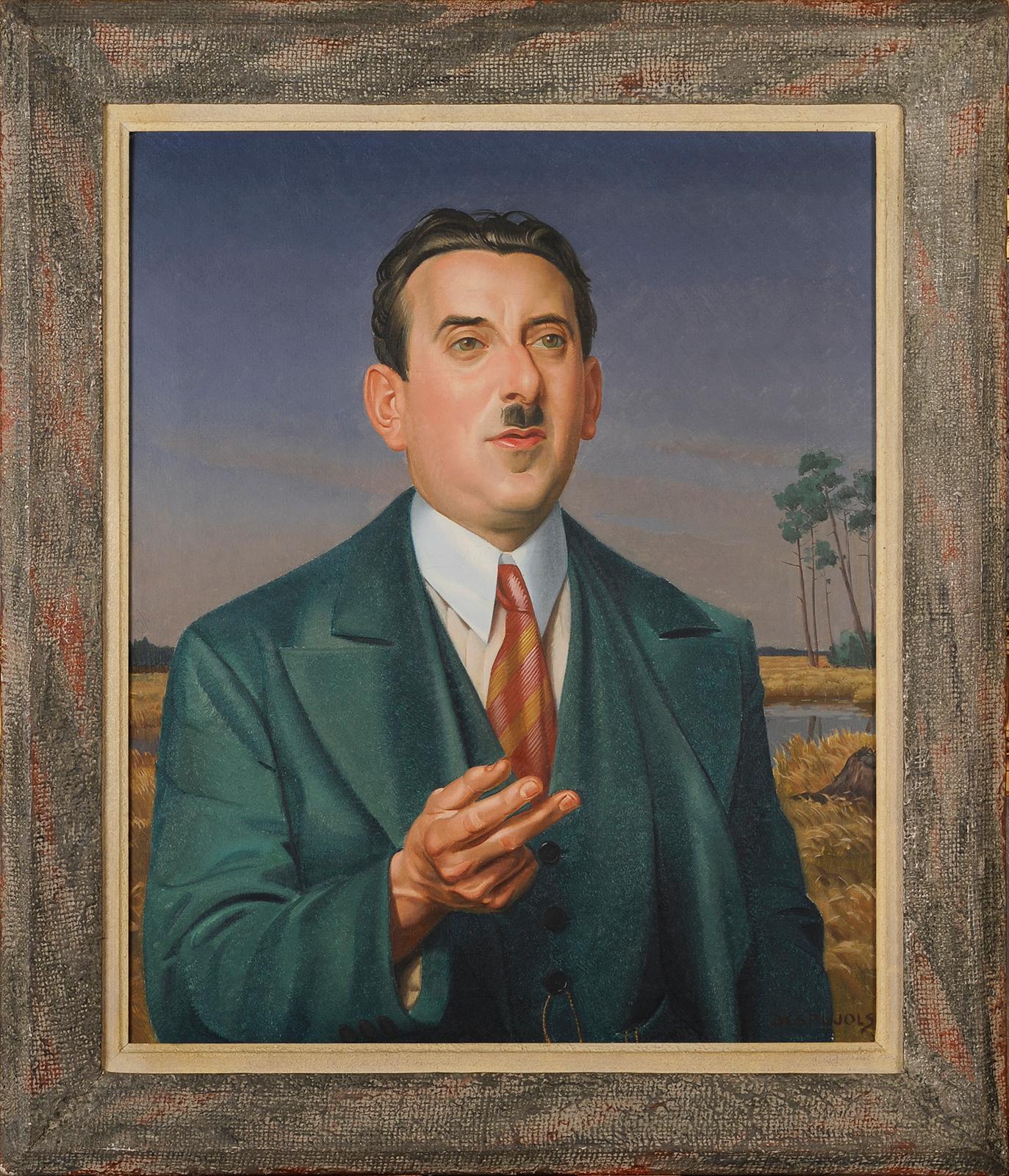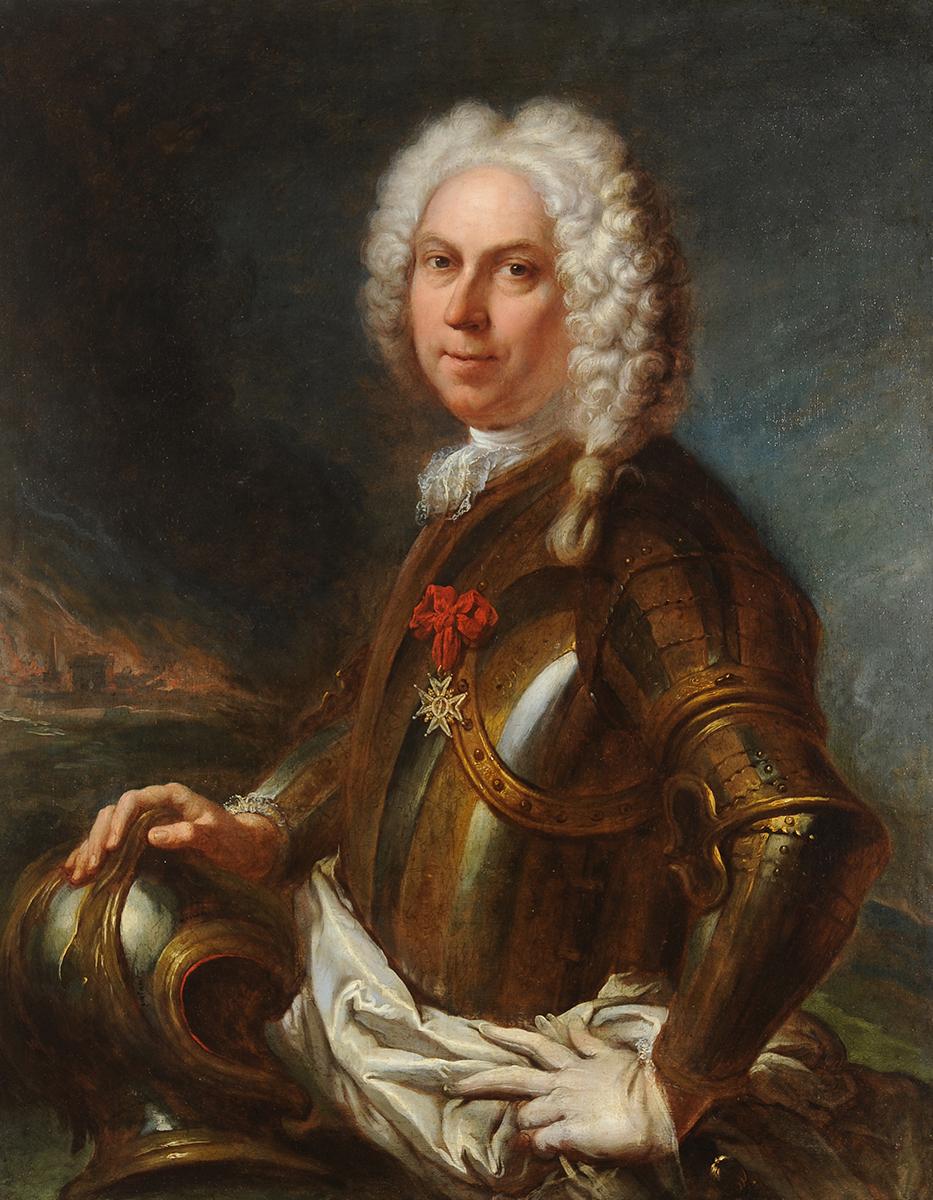Items Similar to French Portrait Mysterious lady 19th century Oil painting Acknowledged master
Want more images or videos?
Request additional images or videos from the seller
1 of 12
French Portrait Mysterious lady 19th century Oil painting Acknowledged mastere.g. 1820-1829
e.g. 1820-1829
About the Item
Unsigned but attributed to acknowledged master Francois-Xavier Fabre (François-Xavier Fabre, 1766 – 1837), French painter of historical subjects. Stylish and perfect portrait of beautiful mature lady believed to be related to Bertin family (Louis-François Bertin 1766 - 1841, est un journaliste et écrivain politique français) of Napoleonic period ca 1803-1810. The lady with the same shy half-smile is delightfully plump. The neckline is shyly covered with a transparent scarf, the folds of a silk black dress with a sky-colored shawl are perfectly conveyed. All the same playful curls of hair on the forehead.
Size app.: 74 x 59.5 cm (roughly 29.1 x 23.4 in). Very Good condition, minimal wear, losses and repairs incl. retouches; edge of canvas relined, conserved. Please study high-res pictures for cosmetic condition! In person actual painting may appear darker or brighter than in our pictures, strictly depending on sufficient light in your environment. Weight of app. 1.8 kg is going to measure some 4 kg volume weight packed for shipment.
Born in Montpellier, Fabre was a pupil of Jacques-Louis David, and made his name by winning the Prix de Rome in 1787. During the French Revolution, Fabre went to live in Florence, becoming a member of the Florentine Academy, where he taught painting. The friends he made in Italy included the dramatist, Vittorio Alfieri, whose widow, Princess Louise of Stolberg-Gedern, Countess of Albany, he is said to have married. On Louise's death in 1824, he inherited her fortune, which he used to found an art school in his home town. On his own death, he bequeathed his own art collection to the town, forming the basis of the Musée Fabre. Fabre began his training in the Montpellier's art academy, where he spent several years prior to joining Jacques-Louis David's studio in Paris. His studies were paid for by the financier and art collector, Philippe-Laurent de Joubert. Philippe-Laurent was the father of Laurent-Nicolas de Joubert. Fabre painted a portrait of Laurent-Nicolas de Joubert, which is now in the Getty Museum. Fabre gained popularity in Florence. The city's Italian aristocrats and tourists were drawn to his elegance, realism, and precision of his portraits. This popularity earned Fabre a place in the Florentine Academy. He became an art teacher, art collector, and art dealer in Florence.
- Attributed to:François-Xavier FABRE (1766 - 1836, French)
- Creation Year:e.g. 1820-1829
- Dimensions:Height: 29.1 in (73.92 cm)Width: 23.4 in (59.44 cm)
- Medium:
- Movement & Style:
- Period:
- Condition:Very Good condition, minimal wear, losses and repairs incl. retouches; edge of canvas relined, conserved. Please study high-res pictures for cosmetic condition!
- Gallery Location:Stockholm, SE
- Reference Number:1stDibs: LU2257212779542
About the Seller
5.0
Gold Seller
These expertly vetted sellers are highly rated and consistently exceed customer expectations.
Established in 1995
1stDibs seller since 2022
18 sales on 1stDibs
Typical response time: 1 hour
- ShippingRetrieving quote...Ships From: Stockholm, Sweden
- Return PolicyA return for this item may be initiated within 14 days of delivery.
More From This SellerView All
- Portrait Young Lady w Tiny Dog 19th Century Watercolor from Wallace CollectionLocated in Stockholm, SEFrançois Theodore Rochard (1798 – 1858) “The Pet Dog”, french, watercolourist, painter, draftsman, miniature painter. Born in Paris, exhibiting at the RA from 1820, brother of the po...Category
Early 19th Century French School Animal Paintings
MaterialsWood, Paper, Watercolor
- American artist Portrait German lady 19th century Oil painting by J. EichholtzLocated in Stockholm, SECeremonial Portrait of Noble German Lady - amazing discovery of hidden monogram "J.E. 1826" disclosing Great American portraitist Jacob Eichholtz (17...Category
1820s Realist Portrait Paintings
MaterialsCanvas, Wood, Oil
- Italian genre scene Family on a halt 19th century Oil painting FramedLocated in Stockholm, SEPacifying painting of cozy scene with Italian family perhaps having rest on the long road. Warm autumn featuring soft sun create this peaceful atmosphere. By anonymous professional o...Category
Late 19th Century Realist Landscape Paintings
MaterialsCanvas, Wood, Oil
- Germany Genre scene Children on swings Painting by Princess Marie AlexandrineLocated in Stockholm, SEPainted in June of 1874 in Bad Driburg by gifted painter Princess Marie Alexandrine of Saxe - Weimar - Eisenach (1849 – 1922), eldest daughter and second child of Charles Alexander, ...Category
Late 19th Century Realist Landscape Paintings
MaterialsCanvas, Wood, Oil
- French Genre scene Little joys in a military hospital 19th century Oil paintingBy Paul (Louis Narcisse) GrolleronLocated in Stockholm, SESignature lower left: Paul Louis Narcisse Grolleron (1848 - 1901). The French painter and illustrator, Paul Grolleron, remains best known for his many well-observed images of the Fra...Category
Late 19th Century Realist Landscape Paintings
MaterialsCanvas, Wood, Oil
- Children w Lamb Scene 18th century Oil painting by French Rococo MasterBy Jean Baptist Marie HuetLocated in Stockholm, SEPainting was attributed to Jean-Baptiste Marie Huet (1745 - 1811) by Cabinet Turquin (France). A cute scene with children tying a ribbon around the neck of a young lamb. Rococo in th...Category
Late 18th Century Rococo Animal Paintings
MaterialsCanvas, Wood, Oil
You May Also Like
- CHILD- Angelo Granati - Italy Figurative Oil on canvas paintingBy Angelo GranatiLocated in Napoli, ITChild - Angelo Granati Italia 2013 -This is his reinterpretation of a greatest old master painting Le Goûter (Just a Taste) by W.A.Bouguereau. Oil on canvas cm. 110x90. Silver leaf...Category
2010s French School Portrait Paintings
MaterialsGold Leaf
- Holy family under an oak tree on a gold backgroundLocated in BELEYMAS, FRFrench school circa 1870 Holy Family under an oak, after Raphaël, on gold background Oil on canvas H. 92 cm; W. 60 cm This aesthetic curiosity takes up the very famous composition b...Category
19th Century French School Portrait Paintings
MaterialsCanvas, Oil
- Portrait of a French manBy Jean DespujolsLocated in BELEYMAS, FRJean DESPUJOLS (Salles 1886 – Shreveport 1965) Portrait of a Henri Martin, mayor of Saint Médard en Jalles (Gironde) Oil on canvas H. 75 cm; L. 60 cm Signed lower right around 1920/2...Category
1920s French School Portrait Paintings
MaterialsCanvas, Oil
- ORIENTAL GIRL- Orientalism- French School Italy figurative Oil on canvas paintBy I. Di MatteoLocated in Napoli, ITOriental girl - I. Di Matteo Italia 1997 - Oil on canvas cm. 60x50. The painting by I. Di Matteo depicts a typically oriental young woman in her hair an...Category
1990s French School Portrait Paintings
MaterialsCanvas, Oil
- Portrait of a man in armorLocated in BELEYMAS, FRAttributed to Jacques DUMONT aka DUMONT LE ROMAIN (Paris 1701 - 1781) Presumed portrait of Louis-Joseph de Formanoir (?-1732) Oil on canvas H. 91.5 cm; ...Category
1750s French School Figurative Paintings
MaterialsCanvas, Oil
- Model undressingLocated in BELEYMAS, FRJulius EXNER (Copenhagen, 1825 - Copenhagen, 1910) Model stripping Oil on canvas H. 122 cm; L. 74 cm Signed and dated 1842 lower right Exhibition: most likely Charlottenborg Salon of 1845, under number 110, titled Modelfigur, awarded with a silver medal Provenance: Emilio Fernando Bolt (c.1860 - 1944), acquired from the artist around 1900, then by descent Our painting was produced as part of the summer sessions organized between 1839 and 1850 by Christoffer Wilhelm Eckersberg (1783-1853), the master of Danish painting of the first half of the 19th century, in his private studio-apartment on the ground floor. floor at the Royal Academy of Fine Arts in Copenhagen. The master brought together a few students there between June and September, rented one or two models for the season, which were painted from different angles, the artists (including Eckersberg himself) sitting side by side. Eckersberg used to paint a fairly small version, the pupils of the larger formats. The work fits more generally into the legendary context of the research and reforms carried out by Eckersberg concerning the studies of nudes and in particular of female nudes, to make this exercise a genre of painting in its own right. Following his two-year stint in Jacques-Louis David's studio in Paris in 1811, Eckersberg had been made aware of work on the nude and in particular on live models, in natural light, while in Denmark the drawings were then only made from casts of antique models or other mannequins. In 1822, when he had been a professor there since 1818, it was he who had the Royal Academy of Copenhagen authorize the study of nudes, no longer in the evening by candlelight, but in natural light; from 1833, it was still he who allowed students to work on nude female models, even if the official authorization of the Academy did not take place until 1839. It was this same year that he instituted his summer sessions, on a private basis, to orient his painting and that of his students towards a new conception of the representation of models: even if the nude remains the real theme, it does not however, this is more than just an academic exercise. The subject is placed in a contemporary interior, with a rather sophisticated decor, and occupied with an intimate activity (it is this type of intimate vein that we will find later in Degas or Cassatt for example); thus in our painting, the young woman is supposed to take off her clothes to wash. The objective is that the viewer forgets that the master and his students are painting a model during a posing session, and that he instead has the impression of being alone with the model, but invisible, almost like a voyeur in spite of himself. Moreover, in these paintings, the model never looks towards the spectator, inducing a psychological distance with him, whereas model and artist are actually physically very close. On the other hand, it is not a question of idealized nudes either, even if Eckersberg, proof of his debt to the antique, chooses fairly classic models and poses. The sensuality is real and very present, with dreamy, even innocent, and timeless expressions (the models do not seem to have a defined age), suave and slow attitudes and movements, and especially with clothes that hide or reveal skillfully parts of the female body: upper buttocks, pronounced hips... Made by an artist under 20, our sensual painting is probably one of the most beautiful and spectacular produced by the students of Eckersberg during these summer sessions. With a perfect balance between the firmness of an ancient statue (it recalls the Venus de Milo) and the softness of the feminine forms, highlighted by a harmonious palette, it captures the attention with many details: the almost photographic folds white clothing...Category
1840s French School Nude Paintings
MaterialsCanvas, Oil
Recently Viewed
View AllMore Ways To Browse
Antique Art Collectors
19th Century French Portraits
French 19th Century Masters
Antique Painting Unsigned
19th Century French Paintings Portraits
Lady Light
French Revolution Painting
19th Century Italian Portraits
19th Century Lady Painting
19th Century Rome Painting
Painting Our Lady
19th Century Painting Of A Lady
Relined Paintings
Aristocrat Art
Antique French Dress Form
Italian Lady Portraits
Portrait Of Italian Lady
Portrait Of A Lady Italian





